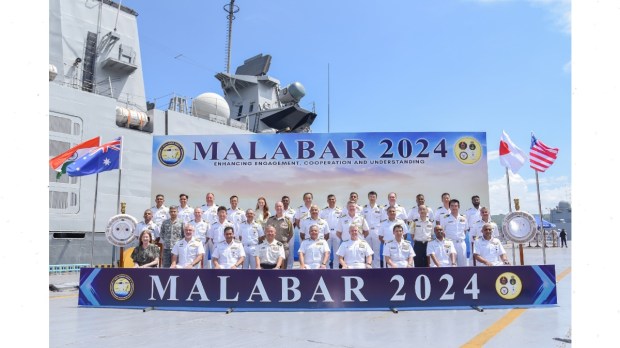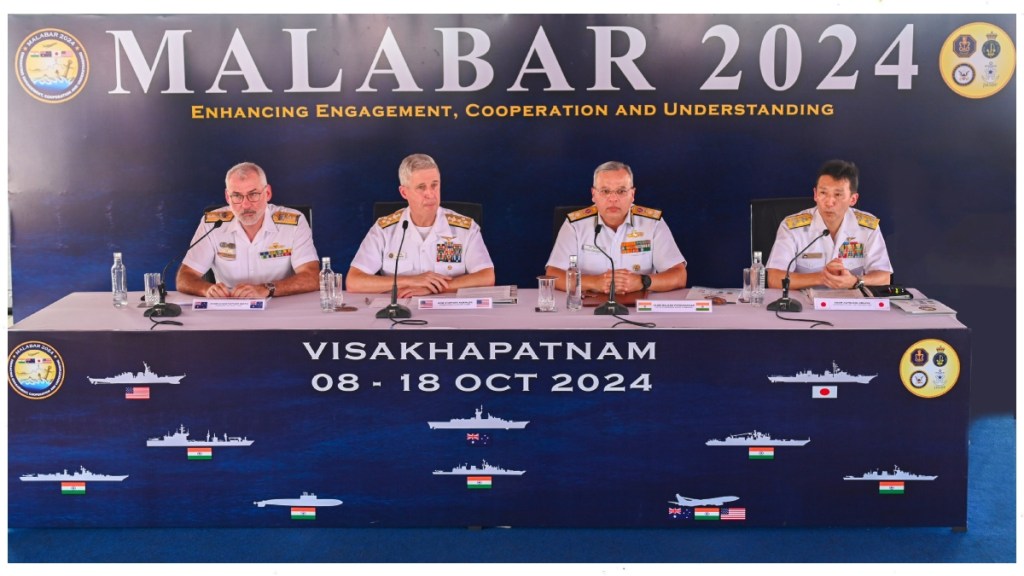The Indo-Pacific has become a focal point for major powers, with the region’s security hanging in the balance amid rising tensions and power projections. A critical response to this dynamic can be found in the annual Exercise Malabar, hosted by the Quad nations—India, the United States, Japan, and Australia—each committed to fostering security and stability in the region. This year’s exercise, led by the Indian Navy, not only exemplifies a strategic shift towards deeper defence diplomacy but also reinforces India’s role as a principal security stakeholder within the Quad.

The Evolution of Malabar and India’s Naval Diplomacy
Since its inception in 1992 as a bilateral exercise between India and the United States, Exercise Malabar has evolved into a significant multilateral forum, expanding in scale and complexity with Japan joining in 2015 and Australia in 2020. The 2024 edition highlights this trajectory, featuring high-intensity drills in anti-submarine warfare, air defence, and situational awareness, with India’s P-8I Poseidon and other advanced assets playing pivotal roles.
Consistent high-level participation has become a hallmark of the exercise, illustrating its importance as a defence diplomacy platform. Recent visits from key military leaders, including Admiral Michael Gilday, Chief of Naval Operations (US Navy) in 2021; Vice Admiral Mark Hammond, Chief of the Royal Australian Navy, in April 2024; and General Angus Campbell, Chief of Australia’s Defence Force, in 2023, affirm the Quad’s united commitment to Malabar. This steady engagement goes to show the exercise’s diplomatic heft, reinforcing the shared Quad vision of a free and open Indo-Pacific. Through Malabar, each Quad nation signals unwavering dedication to regional security, while India strengthens its role as an advocate of maritime stability and resilience.
India’s Strategic Growth in the Quad Framework
India’s leadership role within the Quad’s strategic framework reflects an evolution in its approach to regional security. Historically, India’s policy has favoured non-alignment, maintaining an independent strategic trajectory. However, as China’s maritime activities increase in proximity and assertiveness, the Indian Navy has adapted, now actively shaping the Quad’s priorities in regional security.
The Malabar exercises form a crucial part of this shift, facilitated by India’s investment in high-tech capabilities and key defence partnerships. Recent acquisitions, including P-8I Poseidon patrol aircraft and sonobuoys from the United States, significantly enhance India’s anti-submarine warfare capacity. Additionally, comprehensive logistical support agreements between Quad nations have strengthened operational interoperability, making collaborative deployments more seamless and effective.
India’s central role in the Quad’s security initiatives is not limited to defence drills; it extends to joint training, intelligence exchanges, and personnel integration. This approach aligns India with the Quad’s broader objectives, while also allowing it to exercise significant agency within the framework. Through Malabar, India’s role has expanded from that of a participant to a key strategic driver, shaping the Quad’s long-term security focus while underscoring India’s commitment to regional stability.
Counterbalancing Chinese Maritime Influence
As China continues to assert its presence in the Indian Ocean and South China Sea, India’s strengthened maritime capabilities position the Indian Navy as a critical counterweight. Through high-profile exercises like Malabar, India demonstrates its readiness to uphold a rules-based order and protect freedom of navigation. Malabar 2024’s focus on anti-submarine warfare, in particular, speaks to rising concerns over China’s growing underwater capabilities, with the Indian Navy playing a lead role in safeguarding these contested waters.
Beyond immediate defence objectives, Malabar also highlights India’s commitment to humanitarian assistance and disaster relief (HADR) operations across the region. In recent relief efforts for Papua New Guinea following landslides in May 2024, the Quad’s swift response showcased its capacity for constructive engagement beyond traditional security measures. India’s proactive involvement in HADR reinforces its image as a responsible maritime nation and bolsters the Quad’s credibility as a stabilising force in the Indo-Pacific.
Advancing India’s SAGAR Vision
Integral to India’s strategic engagement in Malabar is its SAGAR (Security and Growth for All in the Region) doctrine, introduced in 2015. This vision aims to foster a safe, cooperative, and inclusive maritime environment through regional collaboration. Malabar 2024, held under the auspices of SAGAR, serves as a potent vehicle for advancing India’s ambitions, illustrating India’s commitment to maintaining a balanced maritime order.
For India, Malabar is not merely a military exercise but an opportunity to reinforce its leadership role in shaping the Indo-Pacific’s security landscape. The exercise brings India’s SAGAR principles to life, providing a platform to promote freedom of navigation and counter maritime challenges. India’s Ministry of Defence noted that this year’s exercises “reflect the importance of India’s growing engagement with like-minded nations,” underscoring how the Quad partnership complements SAGAR’s vision of security and economic growth for all in the region.
Resilience Through Deterrence: The Quad’s Incremental Approach
While the Quad avoids an explicit security mandate, Malabar exemplifies its incremental strategy of resilience through deterrence. This “security without provocation” approach is reflected in both its operational and diplomatic initiatives, such as the Indo-Pacific Maritime Awareness Initiative. By combining high-level surveillance capabilities and satellite monitoring technology, this programme enhances real-time tracking of illicit activities, including illegal fishing and grey-zone tactics. Similarly, the Quad’s newly established maritime legal dialogue is equipping regional allies with a deeper understanding of the United Nations Convention on the Law of the Sea (UNCLOS), helping them to enforce a rules-based order.
Further enhancing deterrence is India’s acquisition of 500 advanced sonobuoys from the United States, aligning it with similar data-sharing efforts under AUKUS. This expanded interoperability positions the Quad as a formidable coalition, capable of maintaining stability without formalising a security alliance.
India’s Balancing Act: Strategic Autonomy and Collective Security
India’s deepening commitment to the Quad and Exercise Malabar comes with a delicate balancing act. Its tradition of strategic autonomy remains central to its foreign policy, and it approaches its role within the Quad with caution, wary of being drawn into direct confrontations. India’s SAGAR doctrine, emphasising inclusive and cooperative security, serves as a guiding framework, enabling India to champion both regional stability and its non-aligned principles.
The Indian Navy’s commitment to Malabar thus reflects an evolving, yet cautious approach to collective security. By leveraging its influence within the Quad, India aims to ensure a stable Indo-Pacific while preserving its strategic autonomy. This approach has allowed India to shape the Quad’s security agenda without compromising its independent decision-making.
A Vision for the Future: India and the Indo-Pacific Security Landscape
The Indian Navy’s role within the Quad continues to grow, with Malabar serving as a critical platform for advancing India’s maritime ambitions. Looking ahead, India is likely to deepen its investments in undersea capabilities and advanced surveillance, further reinforcing its position as a leader in Indo-Pacific security. Through sustained engagement in Malabar and the Quad, the Indian Navy exemplifies India’s long-term vision for a resilient and cooperative regional order.
Exercise Malabar 2024 encapsulates this evolving commitment, positioning the Quad as a force for regional security and underscoring India’s influence within it. As the four navies conduct intensive drills off India’s eastern coast, they collectively send a message of resolve and shared ambition to maintain peace and stability across the Indo-Pacific. Through strategic alignment and resilience-building, the Indian Navy’s proactive engagement within the Quad spotlights a broader ambition to champion a rules-based order, reinforcing peace and prosperity amid shifting global dynamics.

